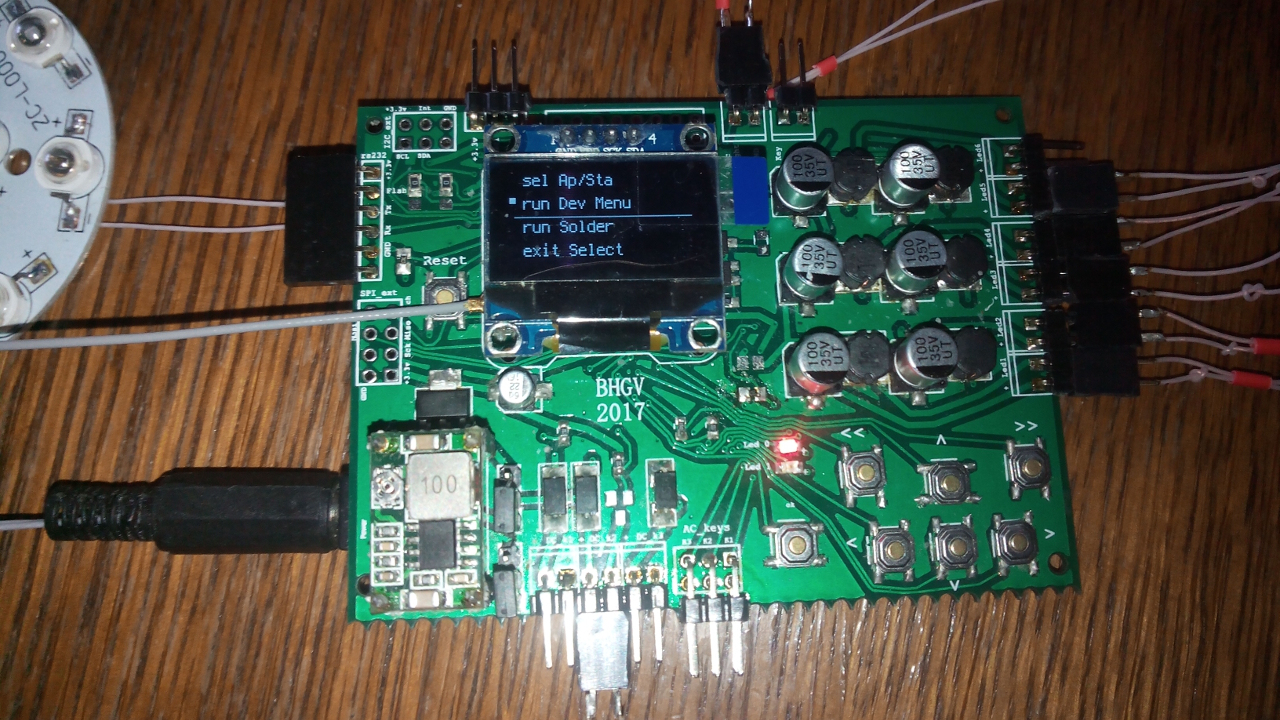It is an OS for ESP8266 IoT microcontrollers based on Lua-RTOS-ESP8266. But it was significally checked, changed and expanded.
schemaic+pcb (Eagle CAD)
-
Lua 5.3.4,
-
Multithreading using Free-RTOS,
-
UART (ttl rs232, com port),
-
I2C,
-
SPI,
-
16 PWMs (hardware),
-
16 PIOs,
-
5 ADC (3 up to 3v + 1 up to 1v + 1 used internally),
-
1 DAC (up to 3v),
-
OLED screen,
-
Keyboard with 8 buttons (cursor + 3 special + 1 external),
-
GUI (menu based. using OLED and keyboard),
-
Shell by remote (rs232) terminal,
-
internal Editor of files (remote terminal),
-
big set of easy to use shell commands (filesystem, ports, devices, network, server, other)
-
net Ap and Sta modes,
-
one command WiFi Sta search,
-
PID regulator module,
-
Webserver (with compressing):
- static HTML,
- CGI,
- WebSock (up to 5 connections),
- direct access to devices/ports using WebSock,
-
9p2000/Styx (Plan9/Inferno os) distributed network virtual file system + server:
- list of devices (ex:
ls /n/dev), - list of device's functions (ex:
cat /n/dev/pwm), - call a device's function (ex:
echo ch_val -i 5 -n 0.4 > /n/dev/pwm), - read the result of the function's call (ex:
<> /n/dev/pwm {echo ch_val -i 5 >[1=0]; read}), - read a file/folder list from the fisical filesystem of the device (ex:
ls /n/fs/html/js), - read/write/create files on the device's fisical filesystem (ex:
cat /n/fs/html/js/common.jsorecho a Text > /n/fs/afile.txt), - create new folders on the device's fisical filesystem (ex:
mkdir /n/fs/new_folder), - remove files or folders from the fisical device's filesystem (ex:
rm /n/fs/html/a_file_or_folder), - RPC channel (synthetic file
/rpc). it allows to send Lua chunk to the device, run it there and return the result. (ex:<> /n/rpc {echo 'pwm[5] = 0.2; return "adc_1=", adc[1];' >[1=0]; read}), - user's CGI-like synthetic files. (ex: on the remote device:
styx.addfile("a_file", function(a) return a + 8; end);, from the inferno-shell:<> /n/a_file {echo -n 10.9 >[1=0]; read}).
- list of devices (ex:
-
PC-Studio for easyer upload/download/edit files into/from/on the luOS9p embedded filesystem. also PC-Studio contains remote terminal for luOS9p and other features (in the future). It is written on the Lua and may be edited/expanded easily. It also contains a plugin system for extensions, but it isn't activated for now.
./bld.sh # build
./flash.sh # flash
cd pc-studio
./bld.sh
cd pc-studio/bld
./prg
In the device's console or from the lua script:
thread.start( styx.loop )
Or just select Styx server on the device's gui if you are using LuOS9p-PCB (or other with ported GUI driver)
In the inferno shell/script/limbo etc:
mount -A tcp!<IP address of your device>!6701 /n
Now your IoT device's styx virtual fs is mounted to /n folder, including branches for drivers /dev and for access to the fisical filesystem of the your IoT device /fs. Use it as a regular filesystem.
For this OS was designed a special PCB that included all the necessary hardware/drivers and supports all the features of the OS.
 But the OS may be used with the most esp8266-based boards (maybe with changes in the drivers part of the OS according to the target hardware)
But the OS may be used with the most esp8266-based boards (maybe with changes in the drivers part of the OS according to the target hardware)